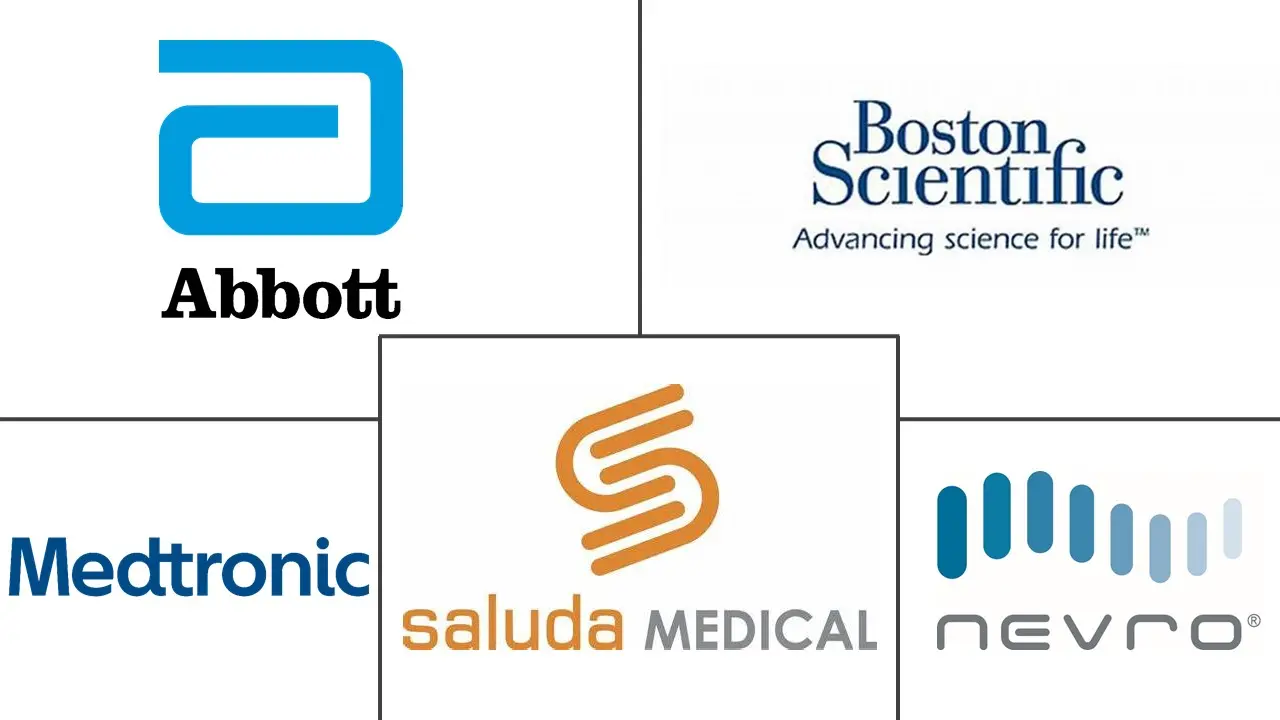Spinal Cord Stimulation Devices Market Size and Share
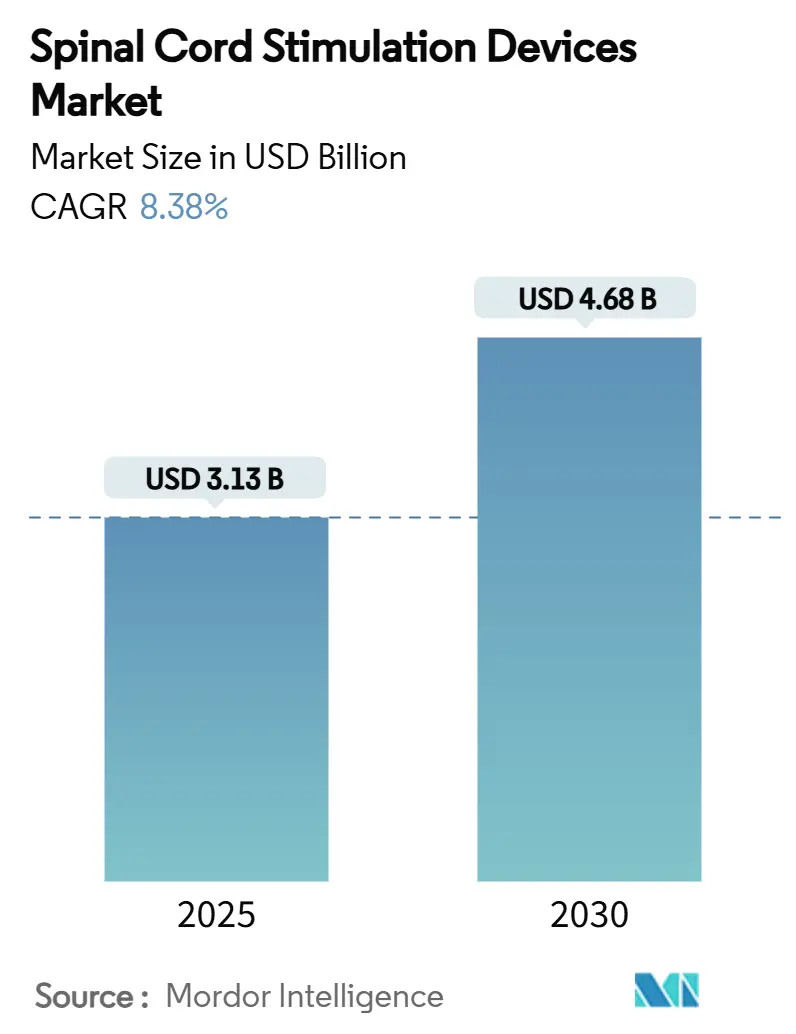
Spinal Cord Stimulation Devices Market Analysis by Mordor Intelligence
The spinal cord stimulation devices market is valued at USD 3.13 billion in 2025 and is projected to reach USD 4.68 billion by 2030, expanding at an 8.38% CAGR. Adoption accelerates as physicians transition from fixed-output implants to AI-enabled closed-loop systems that tailor therapy in real time, cutting overstimulation and reducing revision risk. Growing evidence for 10 kHz high-frequency and burst waveforms, coupled with favorable reimbursement for diabetic neuropathy and non-surgical back pain, sustains long-term demand.[1]Center for Devices and Radiological Health Staff, “Spectra WaveWriter, WaveWriter Alpha, WaveWriter Alpha Prime Spinal Cord Stimulation Systems,” U.S. Food and Drug Administration, fda.gov Hospitals remain the dominant implant setting, yet outpatient centers capture share as minimally invasive techniques shorten recovery times. Regionally, North America leads on the back of early technology uptake, while Asia-Pacific records double-digit growth as healthcare infrastructure expands and chronic pain prevalence rises.
Key Report Takeaways
- By device type, rechargeable systems held 66.71% of spinal cord stimulation devices market share in 2024, while closed-loop ECAP-controlled platforms are forecast to grow at a 12.34% CAGR through 2030.
- By waveform technology, conventional tonic stimulation retained 42.51% revenue in 2024; high-frequency 10 kHz therapy is expected to advance at a 10.7% CAGR over 2025-2030.
- By application, failed back surgery syndrome contributed 31.24% of spinal cord stimulation devices market size in 2024, whereas peripheral neuropathies are projected to expand at 11.23% CAGR to 2030.
- By end user, hospitals accounted for 55.63% of procedures in 2024, while ambulatory surgical centers are growing fastest at 10.44% CAGR to 2030.
- By implant lead type, percutaneous leads captured 63.46% share in 2024; paddle leads are set to post an 11.09% CAGR through 2030.
- By geography, North America led with 42.13% revenue share in 2024, while Asia-Pacific is on track for a 10.43% CAGR to 2030.
Global Spinal Cord Stimulation Devices Market Trends and Insights
Drivers Impact Analysis
| Driver | (~) % Impact on CAGR Forecast | Geographic Relevance | Impact Timeline |
|---|---|---|---|
| Chronic neuropathic pain prevalence | +1.8% | Global, highest in North America & Europe | Long term (≥ 4 years) |
| Rapid uptake of minimally invasive implants | +1.5% | North America & Europe, expanding to Asia-Pacific | Medium term (2-4 years) |
| Reimbursement expansions | +1.2% | North America primary, Europe secondary | Medium term (2-4 years) |
| Rising outpatient ASC implant volumes | +1.0% | North America & Europe | Short term (≤ 2 years) |
| AI-driven closed-loop algorithms | +1.3% | Global, led by developed markets | Medium term (2-4 years) |
| MRI-conditional, miniaturized long-life IPGs | +0.9% | Global | Long term (≥ 4 years) |
| Source: Mordor Intelligence | |||
Growing Prevalence of Chronic Neuropathic Pain
Chronic neuropathic pain affects a growing diabetic population and fuels sustained demand for neuromodulation that pharmaceuticals fail to control. Ten kilohertz high-frequency therapy delivered 90% pain-relief responders at 24 months versus 2% for medical management, prompting guideline shifts away from opioid reliance.[2]Erika Petersen, “Spinal Cord Stimulation Provides Pain Relief in Diabetic Neuropathy,” Cleveland Clinic Journal of Medicine, ccjm.orgRegulators now authorize spinal cord stimulation for diabetic neuropathy and non-surgical back pain, enlarging the eligible pool. As aging, obesity, and sedentary lifestyles converge, clinicians increasingly consider neuromodulation early in the care pathway. This fundamental change anchors stable unit growth and underpins the long-run expansion of the spinal cord stimulation devices market.
Rapid Adoption of Minimally-Invasive Neuromodulation
Percutaneous leads inserted through a single needle now rival paddle systems in efficacy while cutting operating-room time and infection risk. The shift supports same-day discharge, aligns with value-based purchasing, and broadens access for high-comorbidity patients. Remote programming and imaging guidance further streamline workflows, enabling ambulatory centers to capture rising case volumes. As payers reward cost-efficient care, minimally invasive protocols accelerate overall procedure growth and widen the installed base that drives future replacement demand across the spinal cord stimulation devices market.
Favorable Reimbursement Expansions
Medicare’s 2025 code revisions carved out separate payment for adaptive closed-loop stimulators, acknowledging their distinctive clinical value. Private insurers mirror these moves, embedding opioid-reduction metrics into coverage decisions. Europe follows suit as health-technology assessments show long-term cost savings versus repeat surgeries. Clearer economic signals reassure hospitals and ASCs that investments in advanced generators will be recouped, reinforcing order pipelines for leading vendors.
AI-Driven Closed-Loop Stimulation Algorithms
Evoked compound action potential sensing adjusts output up to 50 times per second, keeping patients within an optimal therapeutic window regardless of posture. In a 12-month study, 93% reported less overstimulation and 88% preferred automatic regulation. Machine-learning engines refine settings over time, delivering personalized pain control and reducing unplanned clinic visits. As early adopters publicize results, competitive pressure mounts on legacy-only portfolios, catalyzing a fresh upgrade cycle in the spinal cord stimulation devices market.
Restraints Impact Analysis
| Restraint | (~) % Impact on CAGR Forecast | Geographic Relevance | Impact Timeline |
|---|---|---|---|
| Surgical revision & explant rates | -1.4% | Global, higher in developing markets | Medium term (2-4 years) |
| Capital intensity for small ASC entrants | -0.8% | North America & Europe | Short term (≤ 2 years) |
| Cyber-security and data-privacy concerns | -0.6% | Global, highest in regulated markets | Long term (≥ 4 years) |
| Lithium-ion battery supply volatility | -0.7% | Global | Medium term (2-4 years) |
| Source: Mordor Intelligence | |||
Surgical Revision & Explant Rates
Device removals reach 38% in certain cohorts, with efficacy loss driving 79% of explants and infection 12.4%. Cumulative risk climbs over the device life, inflating total cost of care by USD 35,000–70,000 per revision. High revision rates prompt cautious payer review and can delay first-line adoption. Manufacturers answer with improved anchoring, contact redundancy, and better infection-control coatings, yet durability remains a top clinician concern restraining the spinal cord stimulation devices market.
Cyber-Security & Data-Privacy Concerns
Wi-Fi- and Bluetooth-enabled stimulators expose new attack surfaces as therapy settings can be adjusted remotely. Regulators now require vulnerability assessments and over-the-air patch capabilities, lengthening development cycles. Hospitals, wary of ransomware, sometimes restrict networked implants, slowing connected device rollouts. Vendors invest in zero-trust architectures and encrypted communication, but persistent perception risks temper growth, especially for cloud-dependent closed-loop platforms.
Segment Analysis
By Device Type: Rechargeable Systems Drive Market Evolution
Rechargeable generators dominated with 66.71% share in 2024, reflecting patient demand for fewer replacement operations and the longer functional life of modern lithium-ion cells. This translated into 66.71% of the spinal cord stimulation devices market size in the same year. Vendor roadmaps now promise 15-year battery life and five annual recharges, cutting clinic visits and saving up to USD 168,833 over a lifetime relative to non-rechargeable units.[3]Leonardo Kapural, “Comparison of 10 kHz High-Frequency and Traditional Low-Frequency Spinal Cord Stimulation for the Treatment of Chronic Back and Leg Pain,” Neurosurgery, journals.lww.com Rising experience with at-home inductive charging eases concerns about usability among elderly cohorts. Non-rechargeable devices persist where cognitive or dexterity limits hamper charging compliance, yet their share is expected to erode as training tools improve.
Unit growth stays robust because each new rechargeable implant expands the future replacement market—an annuity well understood by manufacturers. Meanwhile, declining per-unit ASPs and miniaturization enable broader emerging-market access, sustaining double-digit volume growth even as price pressure intensifies. As value-based contracts spread, battery longevity becomes a critical differentiator influencing procurement decisions across health systems.
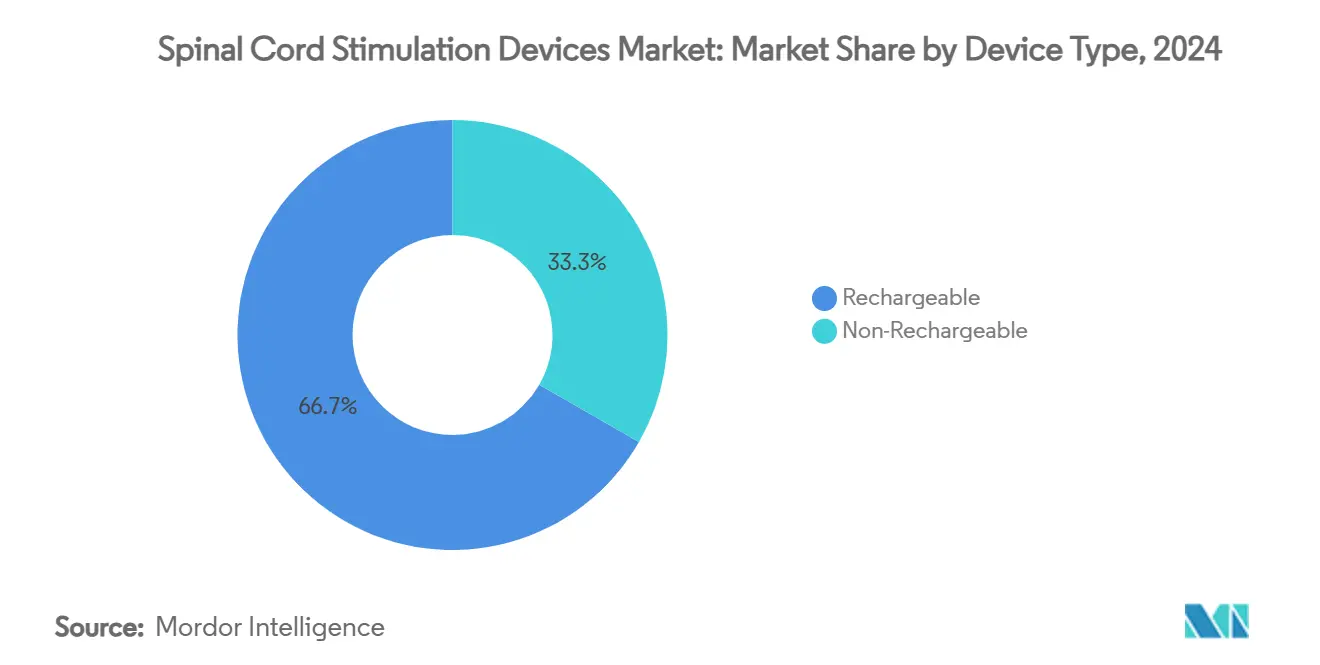
By Waveform Technology: Closed-Loop Systems Reshape Therapeutic Paradigms
Conventional tonic output still represents the single largest revenue block at 42.51% in 2024, but closed-loop ECAP-guided platforms are rising fastest at a 12.34% CAGR. High-frequency 10 kHz implants demonstrate 76.5% responder rates compared with 49.3% for low-frequency peers, widening the performance gap. Burst stimulation mimics natural firing patterns and offers paresthesia-free relief, appealing to patients sensitive to tingling.
The multi-waveform capability packaged in new generators allows physicians to shift between modes without surgical revisions, extending therapy life and boosting patient satisfaction. Vendors exploit proprietary algorithms to lock physicians into ecosystems, while payers scrutinize clinical evidence before covering premium upgrades. As machine learning personalizes waveform selection, therapy shifts from population-based protocols to individualized pain signatures—a transformation expected to redraw competitive boundaries inside the spinal cord stimulation devices market.
By Application: Peripheral Neuropathies Emerge as Growth Driver
Failed back surgery syndrome delivered 31.24% of spinal cord stimulation devices market share in 2024. Peripheral neuropathies, chiefly diabetic, are forecast to grow the fastest at 11.23% CAGR as landmark data show 72.6% pain relief in non-surgical back pain compared with 7.1% under medical management. Robust outcomes spur earlier intervention, moving neuromodulation from salvage therapy to midpoint of care algorithms.
Complex regional pain syndrome benefits from dorsal root ganglion variants that achieve 81.2% success rates, while cancer-related and fibromyalgia indications remain investigational. As disease-specific algorithms mature, clinics increasingly triage patients by electrodiagnostic profiles to match them with optimal waveforms, lifting overall responder rates and reinforcing payer confidence.
By End User: Ambulatory Centers Accelerate Outpatient Adoption
Hospitals retained 55.63% of volumes in 2024—equivalent to 55.63% of the spinal cord stimulation devices market share—yet ASCs are scaling fastest at 10.44% CAGR. Payers incentivize outpatient migration due to 30% lower episode costs. Enhanced imaging and shorter anesthesia protocols make same-day discharge routine. To compete, hospitals form joint ventures with pain specialists and create hybrid OR-ASC suites that preserve inpatient referrals for complex paddle placements.
ASC expansion broadens geographic access, trimming wait times and fueling incremental demand. However, capital outlays for fluoroscopy, neuromonitoring, and inventory deter smaller centers, slowing penetration in rural corridors. Vendor-financed equipment leases and bundled pricing aim to overcome these hurdles.
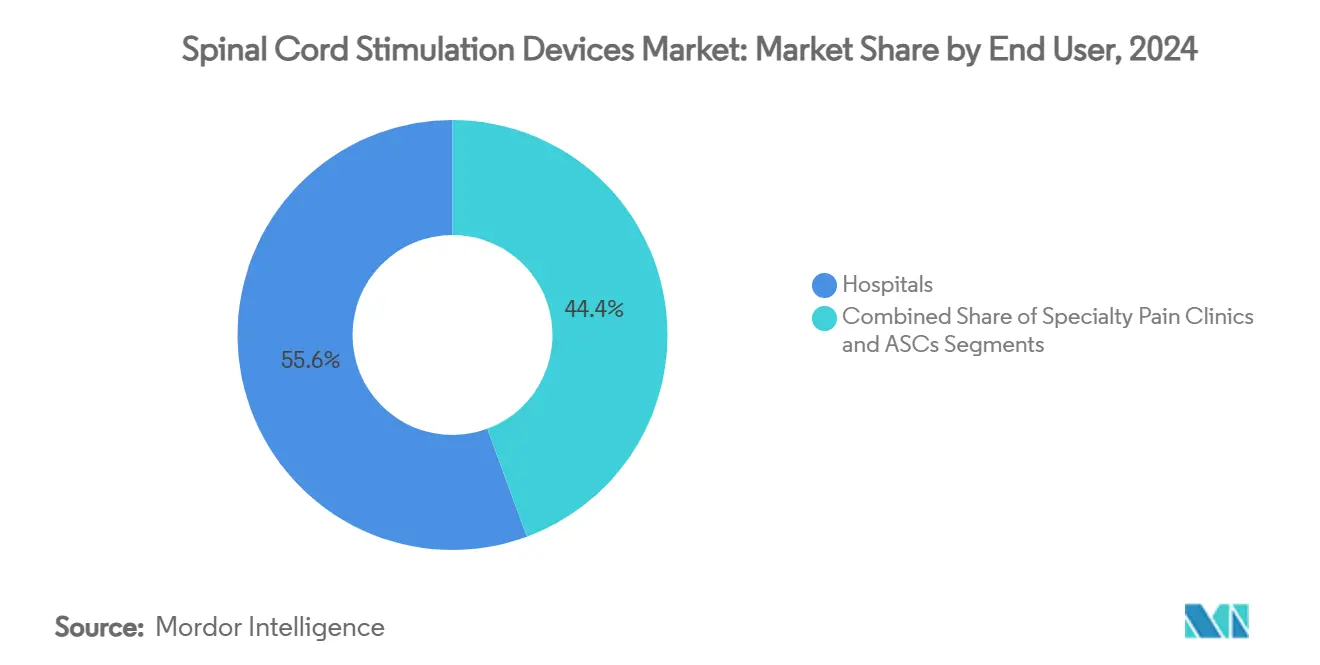
Note: Segment shares of all individual segments available upon report purchase
By Implant Lead Type: Paddle Leads Gain Surgical Preference
Percutaneous leads, with 63.46% share in 2024, remain default for straightforward anatomies. Paddle leads, projected to grow at 11.09% CAGR, now feature up to 32 contacts that offer wider coverage and lower migration risk, cutting long-term revision costs. Yet paddle placement demands laminotomy and advanced surgical skill, limiting uptake to high-volume centers.
Technological crossover is emerging: hybrid systems combine percutaneous trials followed by paddle permanent implants for durable benefit. Innovations such as en-bloc laminoplasty shorten operative time, while softer polymers decrease postoperative discomfort. These advances are expected to accelerate paddle adoption in complex multi-dermatomal pain states.
Geography Analysis
North America held 42.13% of global revenue in 2024, anchored by comprehensive Medicare coverage and streamlined FDA breakthrough pathways that bring closed-loop generators to market quickly. High per-capita healthcare spend supports routine use of advanced imaging and remote programming platforms, raising therapy success rates. U.S. academic centers lead pivotal trials, reinforcing local clinician confidence. Canadian uptake lags slightly due to lengthier device assessments but benefits from nationwide reimbursement uniformity once approval is granted.
Europe presents sizable upside, though market entry is gated by heterogenous payer assessments. Germany and the United Kingdom deploy mature pain programs and now reimburse AI-enabled stimulators, while France and Italy move cautiously under tighter budget caps. The new European Medical Device Regulation demands richer clinical data, favoring incumbents with deep trial portfolios. Recent CE mark clearance of Nevro’s HFX iQ underscores regulatory openness to AI, positioning the region for accelerated closed-loop adoption.
Asia-Pacific is the fastest-growing cluster at a 10.43% CAGR. Japan’s reimbursement for high-frequency therapy and its aging demographic propel sustained demand. China’s tier-1 hospitals invest in neuromodulation centers as diabetes prevalence climbs, though provincial tendering creates price compression. Australia’s temporary withdrawal of certain models on safety grounds opens share for firms with stronger post-market surveillance. India’s private hospital chains explore value-engineered generators to balance affordability with performance, while South Korea quickly integrates cloud monitoring in line with national digital-health policies. Collectively, these factors drive an expanding procedural footprint and steady technology diffusion across the region.
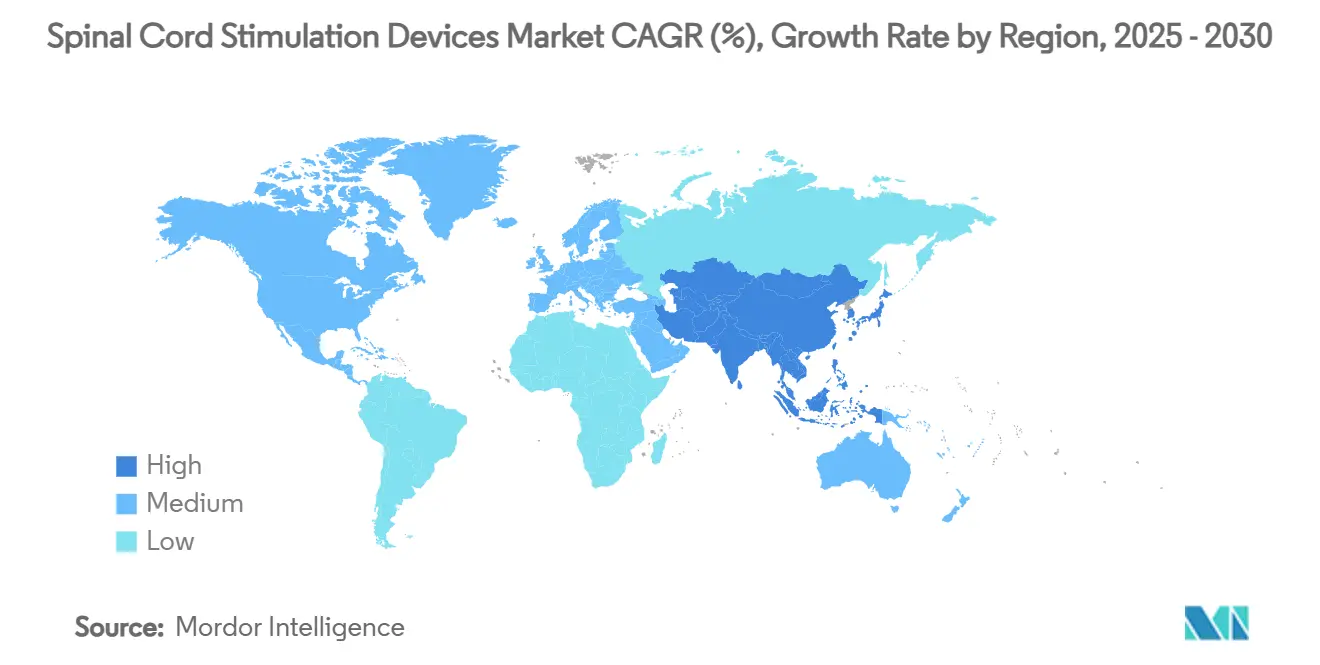
Competitive Landscape
Four multinationals—Medtronic, Abbott, Boston Scientific, and Nevro—control roughly 75% of worldwide sales, reflecting moderate concentration. Medtronic leads in closed-loop sensing, Abbott excels in burst and DRG platforms, Boston Scientific leverages multi-waveform versatility, and Nevro commands high-frequency expertise. Globus Medical’s USD 250 million purchase of Nevro in February 2025 illustrates strategic consolidation aimed at combining surgical spine portfolios with neuromodulation franchises.
R&D race centers on artificial intelligence, energy density, and MR-conditional labeling. Patent walls form around waveform algorithms and miniaturized pulse generators. Emerging entrants pursue pediatrics, cancer pain, and peripheral nerve interfaces, pushing incumbents to defend share through outcome-based contracts and physician education. Supply-chain resilience has become a differentiator as lithium-ion disruptions and semiconductor shortages persist. In response, leading vendors dual-source key components and onshore assembly to safeguard deliveries.
Pricing pressure intensifies as payers benchmark reimbursement to documented opioid reduction and functional-status gains. Vendors therefore pair implants with digital analytics portals that quantify activity levels and pain scores, enabling real-world-evidence dossiers. Those able to link device performance with measurable cost offsets gain preferential formulary status, reinforcing first-mover advantage while raising the bar for followers in the spinal cord stimulation devices market.
Spinal Cord Stimulation Devices Industry Leaders
-
Boston Scientific Corporation
-
Medtronic
-
NEVRO CORP.
-
Saluda Medical Pty Ltd.
-
Abbott
- *Disclaimer: Major Players sorted in no particular order
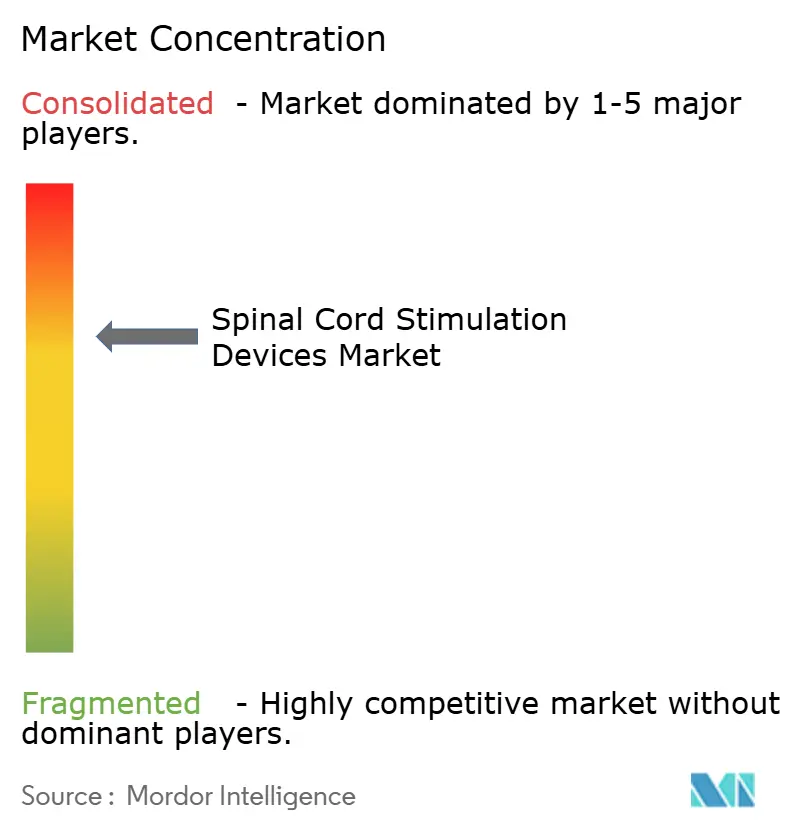
Recent Industry Developments
- February 2025: Globus Medical announced the USD 250 million acquisition of Nevro Corp, integrating the HFX high-frequency platform with its spinal surgery portfolio to broaden chronic pain solutions
- January 2025: Medtronic released 12-month data for Inceptiv, showing 93% of patients experienced reduced overstimulation and 82% achieved ≥ 50% low-back pain reduction, reinforcing closed-loop superiority.
- November 2024: Nevro received CE mark for HFX iQ, combining 10 kHz therapy with cloud-based AI insights for personalized pain algorithms ahead of a Q1 2025 European launch.
Global Spinal Cord Stimulation Devices Market Report Scope
As per the scope, the spinal cord stimulator (SCS) is a type of implantable neuromodulation device which is used to send electrical signals to select areas of the spinal cord for the treatment of certain pain conditions. Spinal cord stimulators consist of thin wires (electrodes) and a small, pacemaker-like battery pack. The electrodes are placed between the spinal cord and the vertebrae (the epidural space), and the generator is placed under the skin. The Spinal Cord Stimulation Devices Market is Segmented by Device Type (Rechargeable and Non-rechargeable), Application (Degenerative Disk Disease, Failed Back Syndrome, Unsuccessful Disk Surgery, and Others), and Geography (North America, Europe, Asia-Pacific, Middle-East and Africa, and South America). The market report also covers the estimated market sizes and trends for 17 different countries across major regions, globally. The report offers the value (in USD million) for the above segments.
| Rechargeable |
| Non-Rechargeable |
| Conventional (Tonic) |
| Burst |
| High-Frequency (10 kHz & above) |
| Closed-Loop / ECAP-Controlled |
| Other Novel Waveforms |
| Failed Back Surgery Syndrome |
| Complex Regional Pain Syndrome |
| Degenerative Disk Disease |
| Peripheral Neuropathies |
| Others |
| Hospitals |
| Ambulatory Surgical Centers |
| Specialty Pain Clinics |
| Percutaneous Leads |
| Paddle Leads |
| North America | United States |
| Canada | |
| Mexico | |
| Europe | Germany |
| United Kingdom | |
| France | |
| Italy | |
| Spain | |
| Rest of Europe | |
| Asia-Pacific | China |
| Japan | |
| India | |
| Australia | |
| South Korea | |
| Rest of Asia-Pacific | |
| Middle East and Africa | GCC |
| South Africa | |
| Rest of Middle East and Africa | |
| South America | Brazil |
| Argentina | |
| Rest of South America |
| By Device Type | Rechargeable | |
| Non-Rechargeable | ||
| By Waveform Technology | Conventional (Tonic) | |
| Burst | ||
| High-Frequency (10 kHz & above) | ||
| Closed-Loop / ECAP-Controlled | ||
| Other Novel Waveforms | ||
| By Application | Failed Back Surgery Syndrome | |
| Complex Regional Pain Syndrome | ||
| Degenerative Disk Disease | ||
| Peripheral Neuropathies | ||
| Others | ||
| By End User | Hospitals | |
| Ambulatory Surgical Centers | ||
| Specialty Pain Clinics | ||
| By Implant Lead Type | Percutaneous Leads | |
| Paddle Leads | ||
| By Geography | North America | United States |
| Canada | ||
| Mexico | ||
| Europe | Germany | |
| United Kingdom | ||
| France | ||
| Italy | ||
| Spain | ||
| Rest of Europe | ||
| Asia-Pacific | China | |
| Japan | ||
| India | ||
| Australia | ||
| South Korea | ||
| Rest of Asia-Pacific | ||
| Middle East and Africa | GCC | |
| South Africa | ||
| Rest of Middle East and Africa | ||
| South America | Brazil | |
| Argentina | ||
| Rest of South America | ||
Key Questions Answered in the Report
1. What is the current size of the spinal cord stimulation devices market?
The spinal cord stimulation devices market is valued at USD 3.13 billion in 2025 and is forecast to reach USD 4.68 billion by 2030.
2. Which device type leads global revenue?
Rechargeable implants led with 66.71% market share in 2024, reflecting patient preference for long battery life and fewer replacement surgeries.
3. How fast is the Asia-Pacific region growing?
Asia-Pacific is projected to expand at a 10.43% CAGR between 2025 and 2030, the fastest among all regions.
4. What technology trend is reshaping therapy delivery?
AI-driven closed-loop stimulation that adjusts output using real-time ECAP feedback is redefining pain management and driving a 12.34% CAGR in that segment.
5. Why are ambulatory surgical centers gaining share?
Minimally invasive percutaneous lead placement and payer incentives for lower-cost outpatient care are propelling ASC procedure volumes at a 10.44% CAGR.
6. Which clinical indication is expected to grow the fastest?
Peripheral neuropathies, particularly diabetic neuropathy, are forecast to grow at 11.23% CAGR due to expanding clinical evidence and newly approved reimbursements.
Page last updated on:
